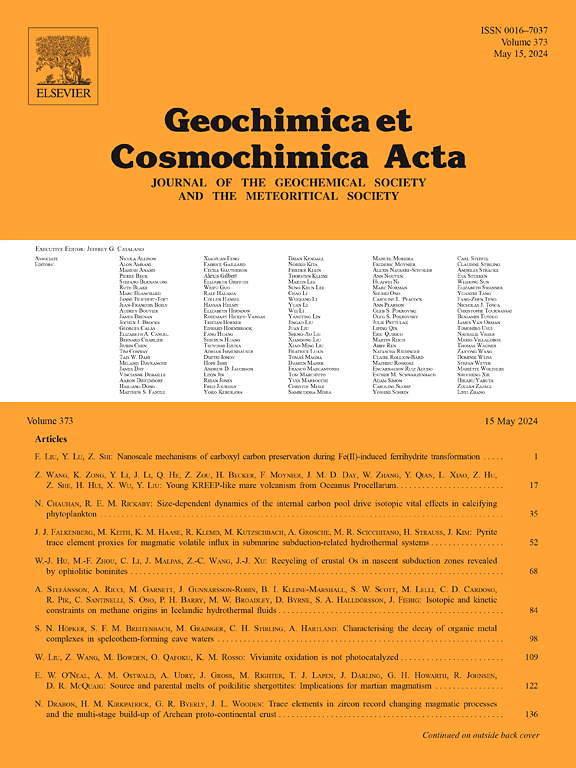Atomic-level insights into nanoclay for prebiotic nucleoside phosphorylation
IF 4.5
1区 地球科学
Q1 GEOCHEMISTRY & GEOPHYSICS
引用次数: 0
Abstract
Kaolinite nanoclay has long been recognized as playing a key role in the origin of life. However, the interaction of kaolinite (Kaol) with biomolecules in prebiotic chemistry and its catalytic mechanism still remain a great challenge. Herein, we comprehensively investigate the nucleoside interactions and phosphorylation processes on Kaol surfaces by a combination of wet-dry cycle experiments and first-principles calculations. The experimental results show that Kaol is able to promote the phosphorylation reactions of four typical nucleosides, but there are differences in the catalytic ability for different nucleosides. In this study, we considered two physicochemically different Kaol end-surfaces—the aluminium-hydroxyl surface (Kaol(001)) and the silica-oxygen surface (Kaol(00原子水平的见解纳米粘土的益生元核苷磷酸化
高岭石纳米粘土长期以来被认为在生命起源中起着关键作用。然而,高岭石与生物分子在益生元化学中的相互作用及其催化机理仍然是一个很大的挑战。在此,我们通过干湿循环实验和第一性原理计算相结合,全面研究了核苷在高岭土表面的相互作用和磷酸化过程。实验结果表明,Kaol能够促进4种典型核苷的磷酸化反应,但对不同核苷的催化能力存在差异。在本研究中,我们考虑了两种物理化学上不同的Kaol端表面——铝羟基表面(Kaol(001))和硅氧表面(Kaol(001¯))——并发现Kaol(001)与核苷形成了强氢键,稳定了核苷,显著降低了磷酸化的动力学屏障。此外,从头算分子动力学(AIMD)模拟表明,Kaol(001)-核苷酸体系具有动力学稳定性,突出了其在保护益生元分子反应位点方面的潜力,为Kaol在益生元化学中的作用提供了强有力的证据。
本文章由计算机程序翻译,如有差异,请以英文原文为准。
求助全文
约1分钟内获得全文
求助全文
来源期刊

Geochimica et Cosmochimica Acta
地学-地球化学与地球物理
CiteScore
9.60
自引率
14.00%
发文量
437
审稿时长
6 months
期刊介绍:
Geochimica et Cosmochimica Acta publishes research papers in a wide range of subjects in terrestrial geochemistry, meteoritics, and planetary geochemistry. The scope of the journal includes:
1). Physical chemistry of gases, aqueous solutions, glasses, and crystalline solids
2). Igneous and metamorphic petrology
3). Chemical processes in the atmosphere, hydrosphere, biosphere, and lithosphere of the Earth
4). Organic geochemistry
5). Isotope geochemistry
6). Meteoritics and meteorite impacts
7). Lunar science; and
8). Planetary geochemistry.
 求助内容:
求助内容: 应助结果提醒方式:
应助结果提醒方式:


